The Use of High Surface Area Mesoporous-Activated Carbon from Longan Seed Biomass for Increasing Capacity and Kinetics of Methylene Blue Adsorption from Aqueous Solution
Abstract
:1. Introduction
2. Materials and Experimental Method
2.1. Materials
2.2. Preparation of Longan Seed-Activated Carbons
2.3. Characterization of the Prepared Activated Carbons
2.4. Methylene Blue Adsorption
2.5. Adsorption Analysis
2.5.1. Adsorption Kinetic Models
2.5.2. Adsorption Isotherm Models
3. Results and Discussion
3.1. Characterization of the Prepared Activated Carbons
3.2. Adsorption Kinetics and Model Testing
3.3. Adsorption Isotherms and Model Testing
3.4. Effect of Process Variables on Methylene Blue Adsorption
3.4.1. Effect of Adsorbent Dosage
3.4.2. Effect of Initial pH
3.4.3. Effect of Temperature and Adsorption Thermodynamics Study
4. Conclusions
Supplementary Materials
Author Contributions
Funding
Institutional Review Board Statement
Informed Consent Statement
Data Availability Statement
Acknowledgments
Conflicts of Interest
References
- Li, X.; Zhang, L.; Yang, Z.; Wang, P.; Yan, Y.; Ran, J. Adsorption materials for volatile organic compounds (VOCs) and the key factors for VOCs adsorption process: A review. Sep. Purif. Technol. 2020, 235, 116213. [Google Scholar] [CrossRef]
- Azari, A.; Nabizadeh, R.; Nasseri, S.; Mahvi, A.H.; Mesdaghinia, A.R. Comprehensive systematic review and meta-analysis of dyes adsorption by carbon-based adsorbent materials: Classification and analysis of last decade studies. Chemosphere 2020, 250, 126238. [Google Scholar] [CrossRef] [PubMed]
- González-García, P. Activated carbon from lignocellulosics precursors: A review of the synthesis methods, characterization techniques and applications. Renew. Sustain. Energy Rev. 2018, 82, 1393–1414. [Google Scholar] [CrossRef]
- Yagub, M.T.; Sen, T.K.; Afroze, S.; Ang, H.M. Dye and its removal from aqueous solution by adsorption: A review. Adv. Colloid Interface Sci. 2014, 209, 172–184. [Google Scholar] [CrossRef] [PubMed]
- Tkaczyk, A.; Mitrowska, K.; Posyniak, A. Synthetic organic dyes as contaminants of the aquatic environment and their implications for ecosystems: A review. Sci. Total Environ. 2020, 717, 137222. [Google Scholar] [CrossRef] [PubMed]
- Bhatnagar, A.; Hogland, W.; Marques, M.; Sillanpää, M. An overview of the modification methods of activated carbon for its water treatment applications. Chem. Eng. J. 2013, 219, 499–511. [Google Scholar] [CrossRef]
- Monser, L.; Adhoum, N. Modified activated carbon for the removal of copper, zinc, chromium and cyanide from wastewater. Sep. Purif. Technol. 2002, 26, 137–146. [Google Scholar] [CrossRef]
- Radovic, L.R.; Silva, I.F.; Ume, J.I.; Menéndez, J.A.; Leon, C.A.L.Y.; Scaroni, A.W. An experimental and theoretical study of the adsorption of aromatics possessing electron-withdrawing and electron-donating functional groups by chemically modified activated carbons. Carbon 1997, 35, 1339–1348. [Google Scholar] [CrossRef]
- Chen, Y.; Zi, F.; Hu, X.; Yang, P.; Ma, Y.; Cheng, H.; Wang, Q.; Qin, X.; Liu, Y.; Chen, S.; et al. The use of new modified activated carbon in thiosulfate solution: A green gold recovery technology. Sep. Purif. Technol. 2020, 230, 115834. [Google Scholar] [CrossRef]
- Nezhad, M.M.; Semnani, A.; Tavakkoli, N.; Shirani, M. Selective and highly efficient removal of uranium from radioactive effluents by activated carbon functionalized with 2-aminobenzoic acid as a new sorbent. J. Environ. Manag. 2021, 299, 113587. [Google Scholar] [CrossRef]
- Faria, P.C.C.; Órfão, J.J.M.; Pereira, M.F.R. Adsorption of anionic and cationic dyes on activated carbons with different surface chemistries. Water Res. 2004, 38, 2043–2052. [Google Scholar] [CrossRef] [PubMed]
- Santoso, E.; Ediati, R.; Kusumawati, Y.; Bahruji, H.; Sulistiono, D.O.; Prasetyoko, D. Review on recent advances of carbon based adsorbent for methylene blue removal from waste water. Mater. Today Chem. 2020, 16, 100233. [Google Scholar] [CrossRef]
- Lu, G.; Nagbanshi, M.; Goldau, N.; Jorge, M.M.; Meissner, P.; Jahn, A.; Mockenhaupt, F.P.; Müller, O. Efficacy and safety of methylene blue in the treatment of malaria: A systematic review. BMC Med. 2018, 16, 59. [Google Scholar] [CrossRef] [PubMed]
- Rafatullah, M.; Sulaiman, O.; Hashim, R.; Ahmad, A. Adsorption of methylene blue on low-cost adsorbents: A review. J. Hazard. Mater. 2010, 177, 70–80. [Google Scholar] [CrossRef]
- Mashkoor, F.; Nasar, A. Magsorbents: Potential candidates in wastewater treatment technology—A review on the removal of methylene blue dye. J. Magn. Magn. Mater. 2020, 500, 166408. [Google Scholar] [CrossRef]
- Katheresan, V.; Kansedo, J.; Lau, S.Y. Efficiency of various recent wastewater dye removal methods: A review. J. Environ. Chem. Eng. 2018, 6, 4676–4697. [Google Scholar] [CrossRef]
- Graham, D. Characterization of Physical Adsorption Systems. III. The Separate Effects of Pore Size and Surface Acidity upon the Adsorbent Capacities of Activated Carbons. J. Phys. Chem. 1955, 59, 896–900. [Google Scholar] [CrossRef]
- Reffas, A.; Bernardet, V.; David, B.; Reinert, L.; Lehocine, M.B.; Dubois, M.; Batisse, N.; Duclaux, L. Carbons prepared from coffee grounds by H3PO4 activation: Characterization and adsorption of methylene blue and Nylosan Red N-2RBL. J. Hazard. Mater. 2010, 175, 779–788. [Google Scholar] [CrossRef] [PubMed]
- Benadjemia, M.; Millière, L.; Reinert, L.; Benderdouche, N.; Duclaux, L. Preparation, characterization and Methylene Blue adsorption of phosphoric acid activated carbons from globe artichoke leaves. Fuel Process. Technol. 2011, 92, 1203–1212. [Google Scholar] [CrossRef]
- Motejadded Emrooz, H.B.; Maleki, M.; Rashidi, A.; Shokouhimehr, M. Adsorption mechanism of a cationic dye on a biomass-derived micro- and mesoporous carbon: Structural, kinetic, and equilibrium insight. Biomass Convers. Biorefinery 2021, 11, 943–954. [Google Scholar] [CrossRef]
- Tseng, R.-L.; Wu, F.-C.; Juang, R.-S. Liquid-phase adsorption of dyes and phenols using pinewood-based activated carbons. Carbon 2003, 41, 487–495. [Google Scholar] [CrossRef]
- Lei, S.; Miyamoto, J.; Kanoh, H.; Nakahigashi, Y.; Kaneko, K. Enhancement of the methylene blue adsorption rate for ultramicroporous carbon fiber by addition of mesopores. Carbon 2006, 44, 1884–1890. [Google Scholar] [CrossRef]
- Sayğılı, H.; Güzel, F. High surface area mesoporous activated carbon from tomato processing solid waste by zinc chloride activation: Process optimization, characterization and dyes adsorption. J. Clean. Prod. 2016, 113, 995–1004. [Google Scholar] [CrossRef]
- Zhang, Z.; Xu, L.; Liu, Y.; Feng, R.; Zou, T.; Zhang, Y.; Kang, Y.; Zhou, P. Efficient removal of methylene blue using the mesoporous activated carbon obtained from mangosteen peel wastes: Kinetic, equilibrium, and thermodynamic studies. Microporous Mesoporous Mater. 2021, 315, 110904. [Google Scholar] [CrossRef]
- Lawtae, P.; Tangsathitkulchai, C. A New Approach for Controlling Mesoporosity in Activated Carbon by the Consecutive Process of Air Oxidation, Thermal Destruction of Surface Functional Groups, and Carbon Activation (the OTA Method). Molecules 2021, 26, 2758. [Google Scholar] [CrossRef]
- Brunauer, S.; Emmett, P.H.; Teller, E. Adsorption of Gases in Multimolecular Layers. J. Am. Chem. Soc. 1938, 60, 309–319. [Google Scholar] [CrossRef]
- Dubinin, M.M. Physical Adsorption of Gases and Vapors in Micropores. In Progress in Surface and Membrane Science; Elsevier: Amsterdam, The Netherlands, 1975; Volume 9, pp. 1–70. [Google Scholar]
- Phothong, K.; Tangsathitkulchai, C.; Lawtae, P. The Analysis of Pore Development and Formation of Surface Functional Groups in Bamboo-Based Activated Carbon during CO2 Activation. Molecules 2021, 26, 5641. [Google Scholar] [CrossRef] [PubMed]
- Tangsathitkulchai, C.; Naksusuk, S.; Wongkoblap, A.; Phadungbut, P.; Borisut, P. Equilibrium and Kinetics of CO2 Adsorption by Coconut Shell Activated Carbon Impregnated with Sodium Hydroxide. Processes 2021, 9, 201. [Google Scholar] [CrossRef]
- Boehm, H.P. Some aspects of the surface chemistry of carbon blacks and other carbons. Carbon 1994, 32, 759–769. [Google Scholar] [CrossRef]
- Boehm, H.P. Surface oxides on carbon and their analysis: A critical assessment. Carbon 2002, 40, 145–149. [Google Scholar] [CrossRef]
- Ocampo-Pérez, R.; Leyva-Ramos, R.; Sanchez-Polo, M.; Rivera-Utrilla, J. Role of pore volume and surface diffusion in the adsorption of aromatic compounds on activated carbon. Adsorption 2013, 19, 945–957. [Google Scholar] [CrossRef]
- Ho, Y.S.; McKay, G. Sorption of dye from aqueous solution by peat. Chem. Eng. J. 1998, 70, 115–124. [Google Scholar] [CrossRef]
- Ho, Y.S.; McKay, G. Pseudo-second order model for sorption processes. Process. Biochem. 1999, 34, 451–465. [Google Scholar] [CrossRef]
- Do, D.D. Adsorption Analysis: Equilibria and Kinetics; World Scientific Publishing Co.: London, UK, 1998; pp. 519–602. [Google Scholar]
- Foo, K.Y.; Hameed, B.H. Insights into the modeling of adsorption isotherm systems. Chem. Eng. J. 2010, 156, 2–10. [Google Scholar] [CrossRef]
- Langmuir, I. The adsorption of gases on plane surfaces of glass, mica and platinum. J. Am. Chem. Soc. 1918, 40, 1361–1403. [Google Scholar] [CrossRef] [Green Version]
- Frenudlich, H.M.F. Over the adsorption in solution. J. Phys. Chem. 1906, 57, 385–471. [Google Scholar]
- Redlich, O.; Peterson, D.L. A Useful Adsorption Isotherm. J. Phys. Chem. 1959, 63, 1024. [Google Scholar] [CrossRef]
- Adamson, T.A.; Adamson, A.W.; Gast, A.P. Physical Chemistry of Surfaces, 6th ed.; Wiley-Interscience: New York, NY, USA, 1997. [Google Scholar]
- Marsh, H.; Rodríguez-Reinoso, F. Activated Carbon; Elsevier Science Ltd.: Oxford, UK, 2006. [Google Scholar]
- Nayak, A.K.; Pal, A. Green and efficient biosorptive removal of methylene blue by Abelmoschus esculentus seed: Process optimization and multi-variate modeling. J. Environ. Manag. 2017, 200, 145–159. [Google Scholar] [CrossRef]
- Thabede, P.M.; Shooto, N.D.; Naidoo, E.B. Removal of methylene blue dye and lead ions from aqueous solution using activated carbon from black cumin seeds. S. Afr. J. Chem. Eng. 2020, 33, 39–50. [Google Scholar] [CrossRef]
- Sahua, S.; Pahia, S.; Tripathya, S.; Kumar, S.S.; Beheraa, A.; Sahu, U.K.; Patel, R.K. Adsorption of methylene blue on chemically modified lychee seed biochar: Dynamic, equilibrium, and thermodynamic study. J. Mol. Liq. 2020, 315, 113743. [Google Scholar] [CrossRef]
- Reid, R.C.; Prausnitz, J.; Sherwood, T.K. The Properties of Gases and Liquids; McGraw-Hill: New York, NY, USA, 1977. [Google Scholar]
- Fogler, H.S. Elements of Chemical Reaction Engineering, 5th ed.; Prentice Hall: New York, NY, USA, 2016. [Google Scholar]
- Dotto, G.L.; Santos, J.M.; Rodrigues, I.L.; Rosa, R.; Pavan, F.A.; Lima, E.C. Adsorption of Methylene Blue by ultrasonic surface modified chitin. J. Colloid Interface Sci. 2015, 446, 133–140. [Google Scholar] [CrossRef] [PubMed]
- Nasrullah, A.; Bhat, A.H.; Naeem, A.; Isa, M.H.; Danish, M. High surface area mesoporous activated carbon-alginate beads for efficient removal of methylene blue. Int. J. Biol. Macromol. 2018, 107, 1792–1799. [Google Scholar] [CrossRef] [PubMed]
- Jawad, A.H.; Rashid, R.A.; Ismail, K.; Sabar, S. High surface area mesoporous activated carbon developed from coconut leaf by chemical activation with H3PO4 for adsorption of methylene blue. Desalination Water Treat. 2017, 74, 326–335. [Google Scholar] [CrossRef] [Green Version]
- Yu, L.; Luo, Y.M. The adsorption mechanism of anionic and cationic dyes by Jerusalem artichoke stalk-based mesoporous activated carbon. J. Environ. Chem. Eng. 2014, 2, 220–229. [Google Scholar] [CrossRef]
- Altenor, S.; Carene, B.; Emmanuel, E.; Lambert, J.; Ehrhardt, J.J.; Gaspard, S. Adsorption studies of methylene blue and phenol onto vetiver roots activated carbon prepared by chemical activation. J. Hazard. Mater. 2009, 165, 1029–1039. [Google Scholar] [CrossRef] [PubMed]
- Islam, M.A.; Ahmed, M.J.; Khanday, W.A.; Asif, M.; Hameed, B.H. Mesoporous activated carbon prepared from NaOH activation of rattan (Lacosperma secundiflorum) hydrochar for methylene blue removal. Ecotoxicol. Environ. Saf. 2017, 138, 279–285. [Google Scholar] [CrossRef] [PubMed]
- Marrakchi, F.; Ahmed, M.J.; Khanday, W.A.; Asif, M.; Hameed, B.H. Mesoporous-activated carbon prepared from chitosan flakes via single-step sodium hydroxide activation for the adsorption of methylene blue. Int. J. Biol. Macromol. 2017, 98, 233–239. [Google Scholar] [CrossRef]
- Foo, K.Y.; Hameed, B.H. Preparation, characterization and evaluation of adsorptive properties of orange peel based activated carbon via microwave induced K2CO3 activation. Bioresour. Technol. 2012, 104, 679–686. [Google Scholar] [CrossRef] [PubMed]
- Dural, M.U.; Cavas, L.; Papageorgiou, S.K.; Katsaros, F.K. Methylene blue adsorption on activated carbon prepared from Posidonia oceanica (L.) dead leaves: Kinetics and equilibrium studies. Chem. Eng. J. 2011, 168, 77–85. [Google Scholar] [CrossRef]
- Patawat, C.; Silakate, K.; Chuan-Udom, S.; Supanchaiyamat, N.; Hunt, A.J.; Ngernyen, Y. Preparation of activated carbon from Dipterocarpus alatus fruit and its application for methylene blue adsorption. RSC Adv. 2020, 10, 21082–21091. [Google Scholar] [CrossRef]
- Auta, M.; Hameed, B.H. Optimized waste tea activated carbon for adsorption of Methylene Blue and Acid Blue 29 dyes using response surface methodology. Chem. Eng. J. 2011, 175, 233–243. [Google Scholar] [CrossRef]
- Islam, M.A.; Ahmed, M.J.; Khanday, W.A.; Asif, M.; Hameed, B.H. Mesoporous activated coconut shell-derived hydrochar prepared via hydrothermal carbonization-NaOH activation for methylene blue adsorption. J. Environ. Manag. 2017, 203, 237–244. [Google Scholar] [CrossRef]
- Chen, C.; Mi, S.; Lao, D.; Shi, P.; Tong, Z.; Li, Z.; Hu, H. Single-step synthesis of eucalyptus sawdust magnetic activated carbon and its adsorption behavior for methylene blue. RSC Adv. 2019, 9, 22248–22262. [Google Scholar] [CrossRef] [Green Version]
- Williams, N.E.; Aydinlik, N.P. KOH ratio effect, characterization, and kinetic modeling of methylene blue from aqueous medium using activated carbon from Thevetia peruviana shell. Chem. Eng. Commun. 2021, 208, 1189–1208. [Google Scholar] [CrossRef]
- Chandra, T.C.; Mirna, M.M.; Ismadji, S. Adsorption of basic dye onto activated carbon prepared from durian shell: Studies of adsorption equilibrium and kinetics. Chem. Eng. J. 2007, 127, 121–129. [Google Scholar] [CrossRef]
- Vargas, A.M.M.; Cazetta, A.L.; Kunita, M.H.; Silva, T.L.; Almeida, V.C. Adsorption of methylene blue on activated carbon produced from flamboyant pods (Delonix regia): Study of adsorption isotherms and kinetic models. Chem. Eng. J. 2011, 168, 722–730. [Google Scholar] [CrossRef]
- Cazetta, A.L.; Vargas, A.M.M.; Nogami, E.M.; Kunita, M.H.; Guilherme, M.R.; Martins, A.C.; Silva, T.L.; Moraes, J.C.G.; Almeida, V.C. NaOH-activated carbon of high surface area produced from coconut shell: Kinetics and equilibrium studies from the methylene blue adsorption. Chem. Eng. J. 2011, 174, 117–125. [Google Scholar] [CrossRef]
- Heidarinejad, Z.; Rahmanian, O.; Fazlzadeh, M.; Heidari, M. Enhancement of methylene blue adsorption onto activated carbon prepared from Date Press Cake by low frequency ultrasound. J. Mol. Liq. 2018, 264, 591–599. [Google Scholar] [CrossRef]
- Wang, J.; Sun, C.; Lin, B.-C.; Huang, Q.-X.; Ma, Z.-Y.; Chi, Y.; Yan, J.-H. Micro- and mesoporous-enriched carbon materials prepared from a mixture of petroleum-derived oily sludge and biomass. Fuel Process. Technol. 2018, 171, 140–147. [Google Scholar] [CrossRef]
- Chen, Y.; Zhai, S.R.; Liu, N.; Song, Y.; An, Q.D.; Song, X.W. Dye removal of activated carbons prepared from NaOH-pretreated rice husks by low-temperature solution-processed carbonization and H3PO4 activation. Bioresour. Technol. 2013, 144, 401–409. [Google Scholar] [CrossRef] [PubMed]
- Gokce, Y.; Yaglikci, S.; Yagmur, E.; Banford, A.; Aktas, Z. Adsorption behaviour of high performance activated carbon from demineralised low rank coal (Rawdon) for methylene blue and phenol. J. Environ. Chem. Eng. 2021, 9, 104819. [Google Scholar] [CrossRef]
- Wu, K.T.; Wu, P.H.; Wu, F.C.; Jreng, R.L.; Juang, R.S. A novel approach to characterizing liquid-phase adsorption on highly porous activated carbons using the Toth equation. Chem. Eng. J. 2013, 221, 373–381. [Google Scholar] [CrossRef]
- Foo, K.Y.; Hameed, B.H. Microwave assisted preparation of activated carbon from pomelo skin for the removal of anionic and cationic dyes. Chem. Eng. J. 2011, 173, 385–390. [Google Scholar] [CrossRef]
- Başar, C.A. Applicability of the various adsorption models of three dyes adsorption onto activated carbon prepared waste apricot. J. Hazard. Mater. 2006, 135, 232–241. [Google Scholar] [CrossRef] [PubMed]
- Deng, H.; Yang, L.; Tao, G.; Dai, J. Preparation and characterization of activated carbon from cotton stalk by microwave assisted chemical activation—Application in methylene blue adsorption from aqueous solution. J. Hazard. Mater. 2009, 166, 1514–1521. [Google Scholar] [CrossRef] [PubMed]
- Ghaffar, A.; Younis, M.N. Interaction and thermodynamics of methylene blue adsorption on oxidized multi-walled carbon nanotubes. Green Process. Synth. 2015, 4, 209–217. [Google Scholar] [CrossRef]
- Giraldo, S.; Robles, I.; Godínez, L.A.; Acelas, N.; Flórez, E. Experimental and Theoretical Insights on Methylene Blue Removal from Wastewater Using an Adsorbent Obtained from the Residues of the Orange Industry. Molecules 2021, 26, 4555. [Google Scholar] [CrossRef] [PubMed]
- Ghasemi, J.; Asadpour, S. Thermodynamics’ study of the adsorption process of methylene blue on activated carbon at different ionic strengths. J. Chem. Thermodyn. 2007, 39, 967–971. [Google Scholar] [CrossRef]
- Yao, Y.; Xu, F.; Chen, M.; Xu, Z.; Zhu, Z. Adsorption behavior of methylene blue on carbon nanotubes. Bioresour. Technol. 2010, 101, 3040–3046. [Google Scholar] [CrossRef]
- Sánchez-Martín, J.; González-Velasco, M.; Beltrán-Heredia, J.; Gragera-Carvajal, J.; Salguero-Fernández, J. Novel tannin-based adsorbent in removing cationic dye (Methylene Blue) from aqueous solution. Kinetics and equilibrium studies. J. Hazard. Mater. 2010, 174, 9–16. [Google Scholar] [CrossRef]
- Nasuha, N.; Hameed, B.H. Adsorption of methylene blue from aqueous solution onto NaOH-modified rejected tea. Chem. Eng. J. 2011, 166, 783–786. [Google Scholar] [CrossRef]
- Wang, P.; Cao, M.; Wang, C.; Ao, Y.; Hou, J.; Qian, J. Kinetics and thermodynamics of adsorption of methylene blue by a magnetic graphene-carbon nanotube composite. Appl. Surf. Sci. 2014, 290, 116–124. [Google Scholar] [CrossRef]
- Ren, Y.; Chen, F.; Pan, K.; Zhao, Y.; Ma, L.; Wei, S. Studies on Kinetics, Isotherms, Thermodynamics and Adsorption Mechanism of Methylene Blue by N and S Co-Doped Porous Carbon Spheres. Nanomater. 2021, 11, 1819. [Google Scholar] [CrossRef]
- Theydan, S.K.; Ahmed, M.J. Adsorption of methylene blue onto biomass-based activated carbon by FeCl3 activation: Equilibrium, kinetics, and thermodynamic studies. J. Anal. Appl. Pyrolysis 2012, 97, 116–122. [Google Scholar] [CrossRef]
- Liu, Y. Is the Free Energy Change of Adsorption Correctly Calculated? J. Chem. Eng. Data 2009, 54, 1981–1985. [Google Scholar] [CrossRef]
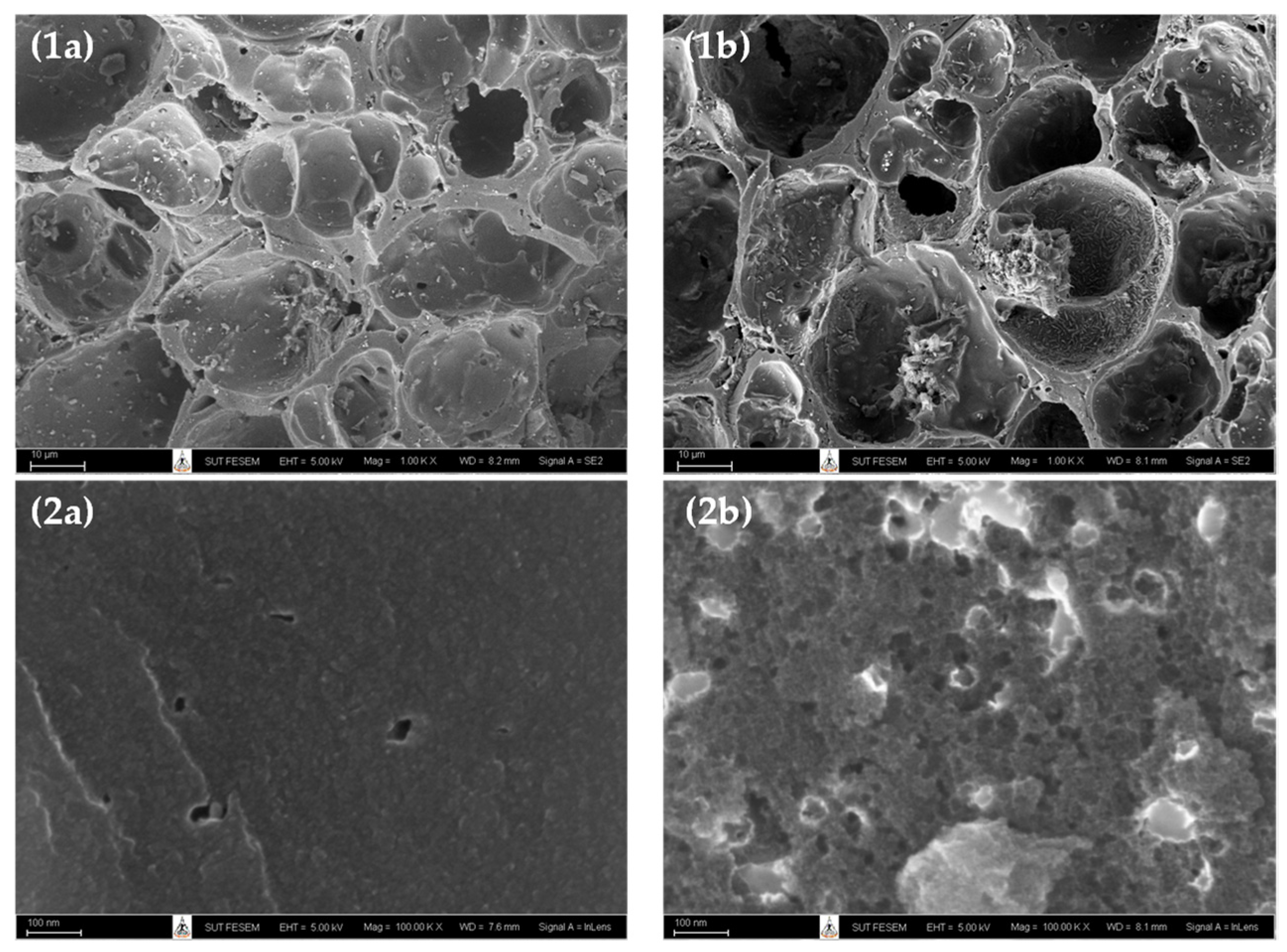
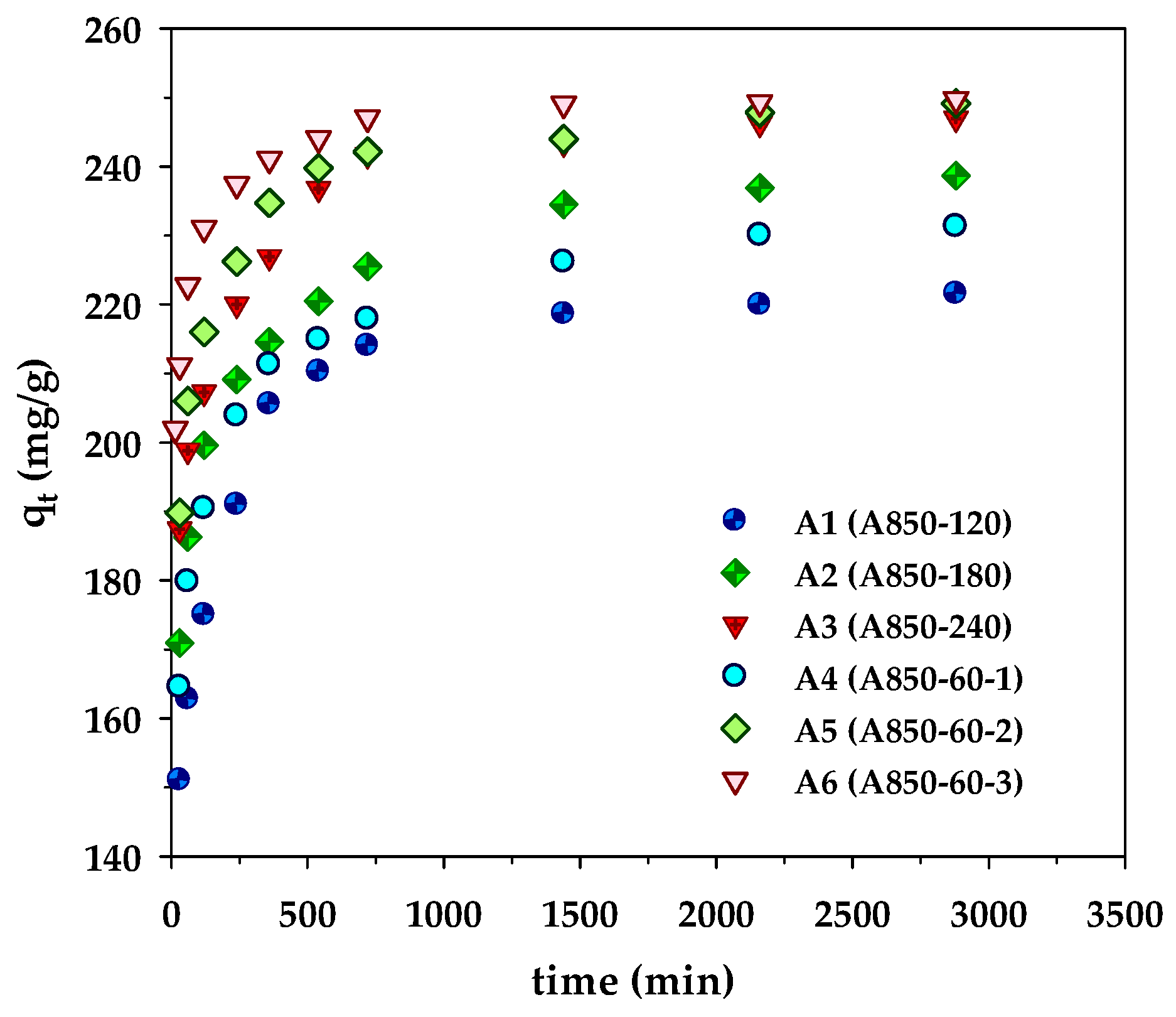
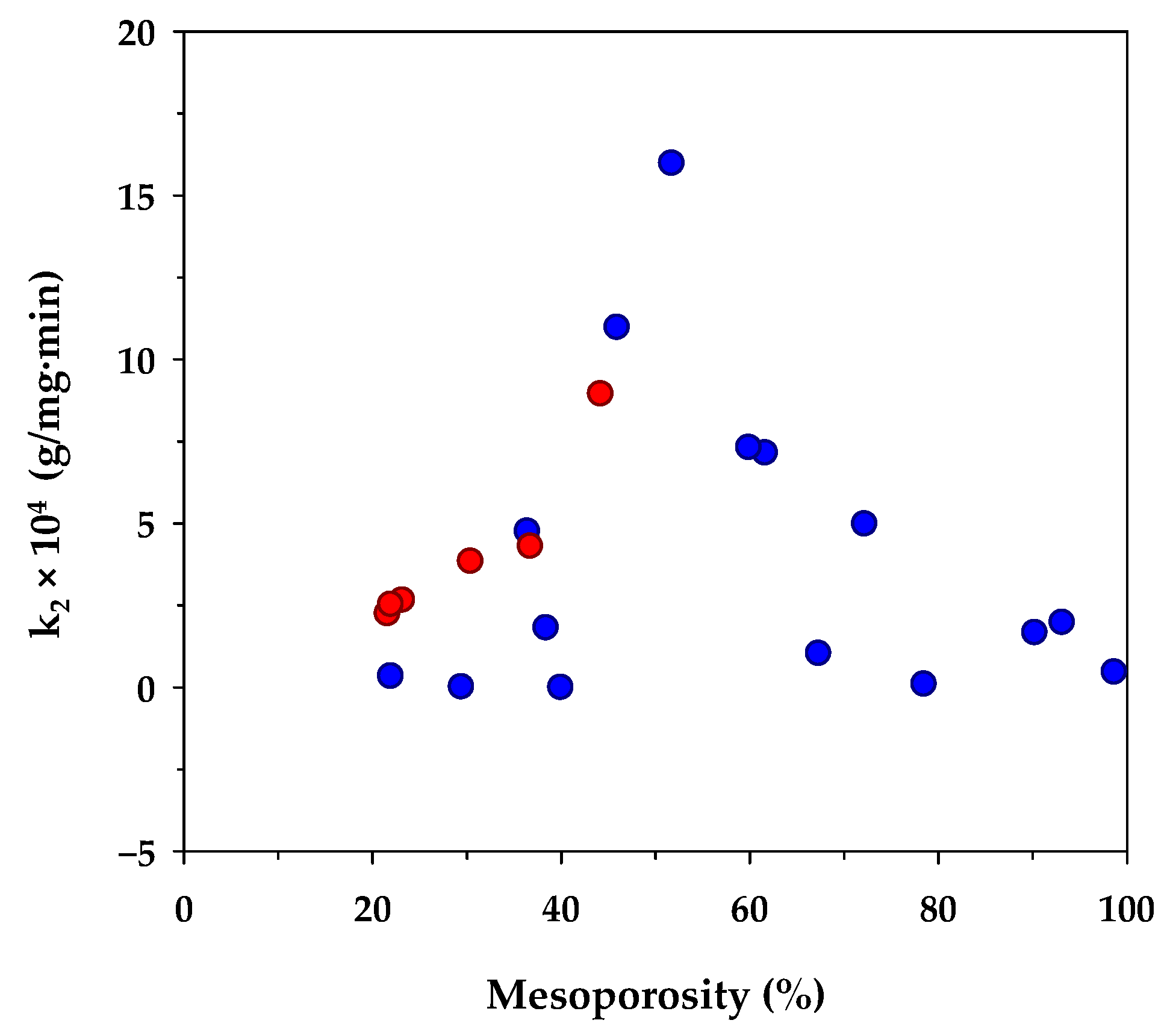
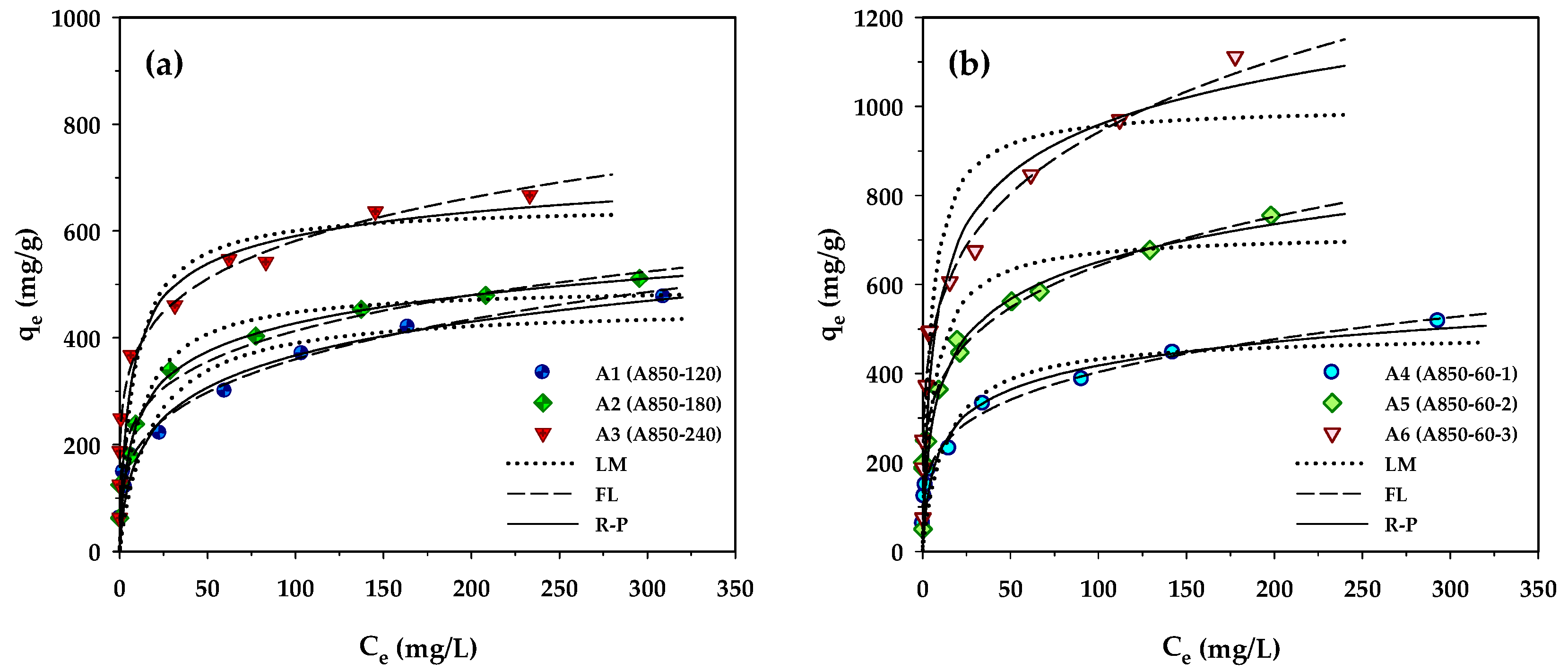
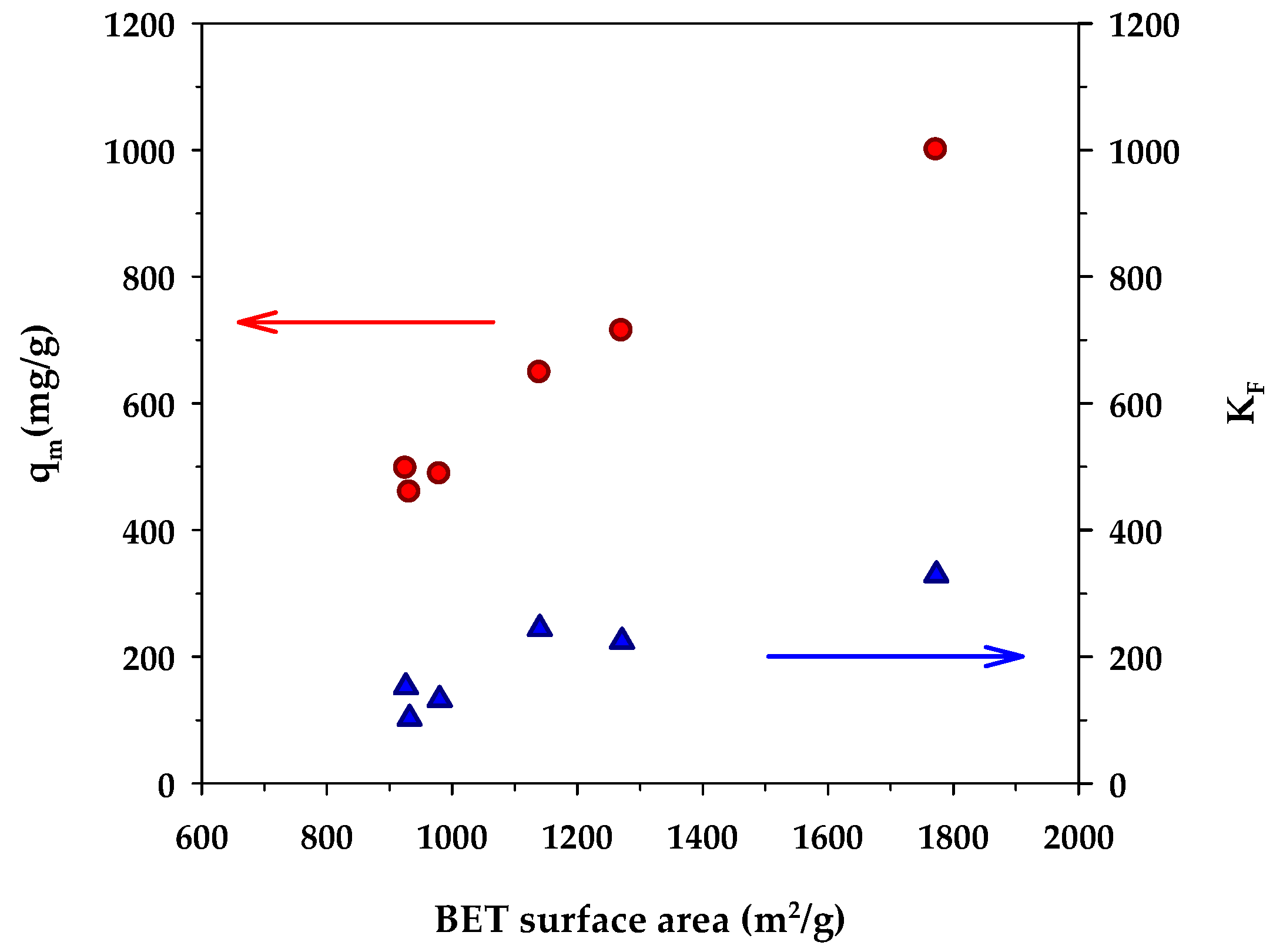
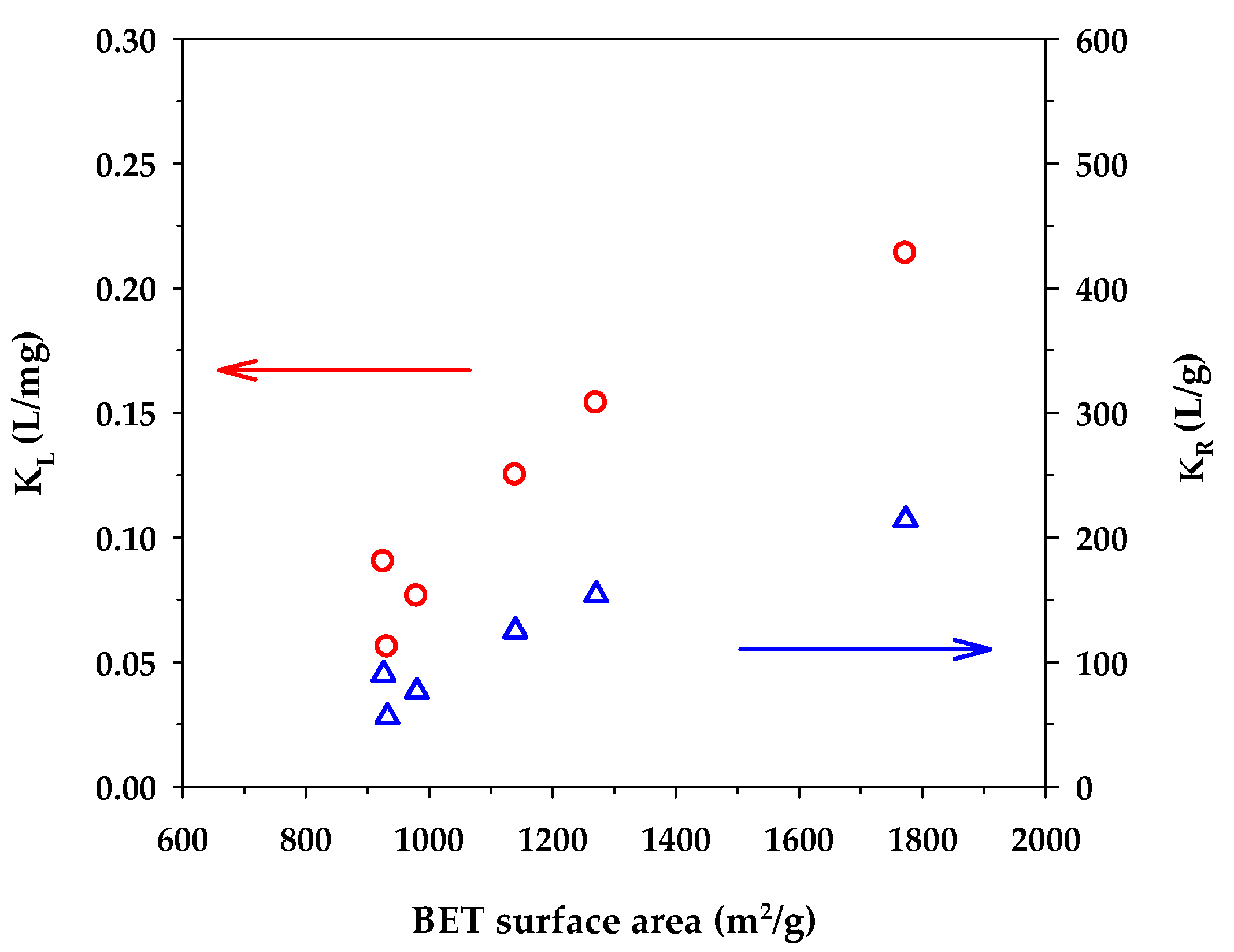
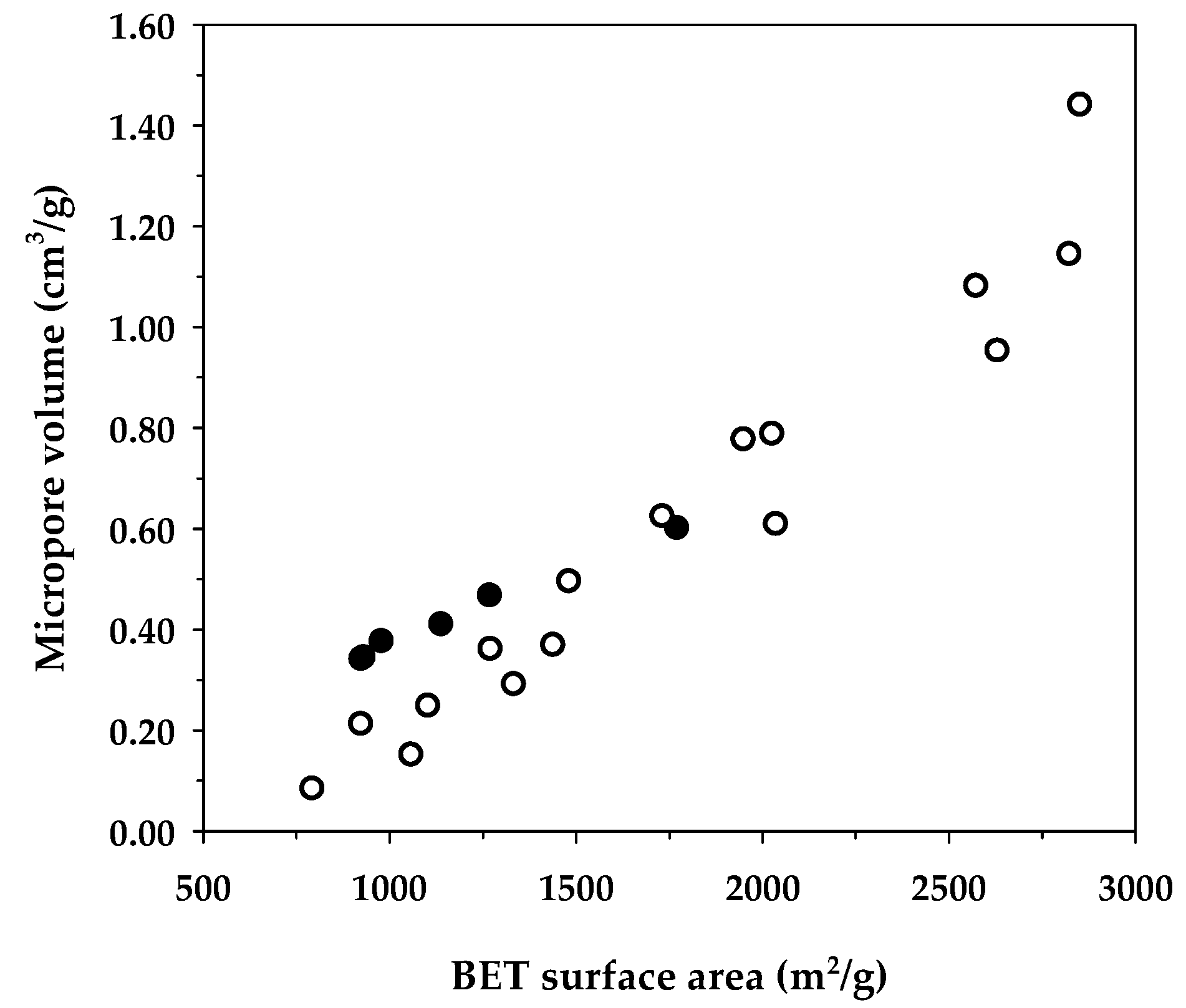
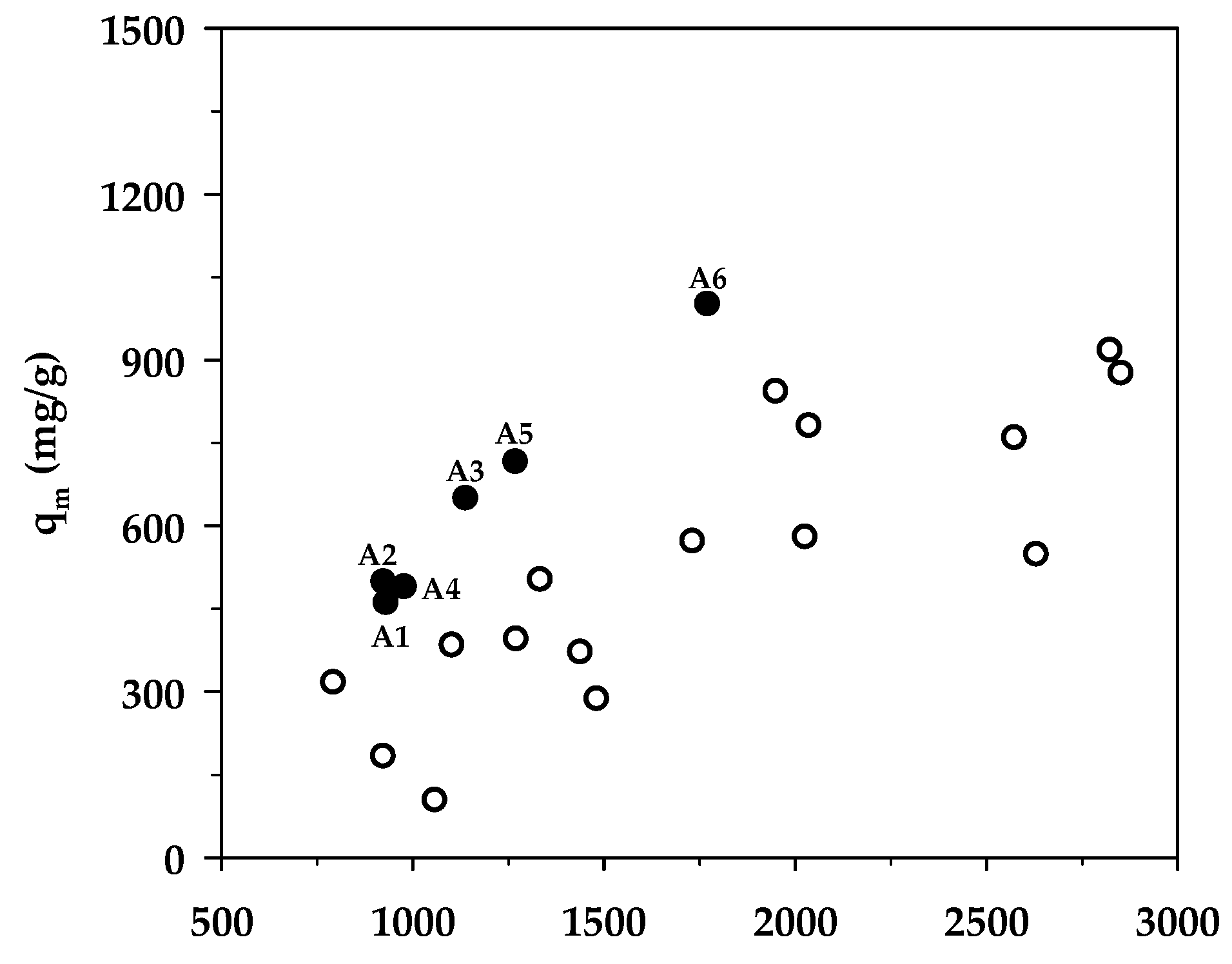




| Studied Variables | Time | Initial Concentration | Carbon Dosage | Temperature | pH |
|---|---|---|---|---|---|
| (h) | (mg/L) | (g) | (°C) | ||
| Time (kinetics) | 0.5–48 | 200 | 0.020 | 35 | 4.5 |
| Equilibrium conc. | 48 | 50–500 | 0.010–0.020 | 35 | 4.5 |
| Adsorbent dosage | 48 | 300 | 0.005–0.050 | 35 | 4.5 |
| Solution pH | 48 | 400 | 0.020 | 35 | 3–11 |
| Temperature | 48 | 50–500 | 0.010–0.020 | 35–55 | 4.5 |
| Sample | Sample | Dav | VMic | VMes | VT | SBET |
|---|---|---|---|---|---|---|
| Code | Name | (nm) | (cm3/g) (%) | (cm3/g) (%) | (cm3/g) | (m2/g) |
| A1 | A850–120 | 1.88 | 0.343 (78.5) | 0.094 (21.5) | 0.437 | 932 |
| A2 | A850–180 | 1.91 | 0.340 (76.9) | 0.102 (23.1) | 0.442 | 926 |
| A3 | A850–240 | 2.06 | 0.409 (69.7) | 0.178 (30.3) | 0.587 | 1140 |
| A4 | A850–60–1 | 1.96 | 0.375 (78.1) | 0.105 (21.9) | 0.480 | 980 |
| A5 | A850–60–2 | 2.32 | 0.466 (63.3) | 0.270 (36.7) | 0.736 | 1271 |
| A6 | A850–60–3 | 2.42 | 0.600 (55.9) | 0.474 (44.1) | 1.074 | 1773 |
| Sample | VT | Pore Volume for Pore Width (cm3/g) | |||
|---|---|---|---|---|---|
| Code | (cm3/g) | 0.65–1.4 nm | 1.4–2 nm | 2–3 nm | 3–4 nm |
| A1 | 0.437 | 0.306 (70.0%) | 0.037 (8.5%) | 0.006 (1.4%) | 0.088 (20.1%) |
| A2 | 0.442 | 0.291 (65.8%) | 0.049 (11.1%) | 0.002 (0.5%) | 0.100 (22.6%) |
| A3 | 0.587 | 0.307 (52.3%) | 0.102 (17.4%) | 0.012 (2.0%) | 0.166 (28.3%) |
| A4 | 0.480 | 0.309 (64.4%) | 0.066 (13.7%) | 0.046 (9.6%) | 0.059 (12.3%) |
| A5 | 0.736 | 0.339 (46.1%) | 0.127 (17.2%) | 0.176 (23.9%) | 0.094 (12.8%) |
| A6 | 1.074 | 0.207 (19.3%) | 0.393 (36.6%) | 0.330 (30.7%) | 0.144 (13.4%) |
| Sample | pHPZC | Acidic Groups | Basic Groups | Total |
|---|---|---|---|---|
| Code | (mmol/g) | (mmol/g) | (mmol/g) | |
| A1 | 8.77 | 0.243 (20.5%) | 0.941 (79.5%) | 1.184 |
| A2 | 8.81 | 0.334 (22.4%) | 1.160 (77.6%) | 1.494 |
| A3 | 9.48 | 0.400 (23.1%) | 1.329 (76.9%) | 1.729 |
| A4 | 9.36 | 0.152 (10.5%) | 1.295 (89.5%) | 1.447 |
| A5 | 9.54 | 0.218 (14.1%) | 1.331 (85.9%) | 1.549 |
| A6 | 9.94 | 0.251 (14.4%) | 1.491 (85.6%) | 1.742 |
| Code | Pseudo-First Order | Pseudo-Second Order | Pore-Diffusion | |||||||||
|---|---|---|---|---|---|---|---|---|---|---|---|---|
| qe | k1 | R2 | Δq | qe | k2 × 104 | R2 | Δq | qe | De × 107 | R2 | Δq | |
| (mg/g) | (min−1) | (%) | (mg/g) | (g/mg·min) | (%) | (mg/g) | (cm2/s) | (%) | ||||
| A1 | 206.98 | 0.034 | 0.914 | 8.94 | 222.22 | 2.265 | 1.000 | 4.39 | 218.52 | 4.657 | 0.987 | 5.38 |
| A2 | 221.63 | 0.042 | 0.912 | 6.81 | 238.10 | 2.669 | 1.000 | 4.40 | 235.98 | 4.667 | 0.957 | 5.14 |
| A3 | 232.43 | 0.047 | 0.819 | 6.81 | 240.45 | 3.850 | 1.000 | 3.57 | 244.76 | 6.014 | 0.990 | 4.26 |
| A4 | 215.08 | 0.041 | 0.947 | 7.00 | 232.56 | 2.548 | 1.000 | 4.06 | 226.94 | 4.668 | 0.984 | 4.02 |
| A5 | 236.40 | 0.048 | 0.895 | 5.39 | 243.15 | 4.312 | 1.000 | 2.51 | 241.39 | 10.762 | 0.989 | 3.85 |
| A6 | 239.91 | 0.110 | 0.805 | 5.09 | 246.60 | 8.962 | 1.000 | 1.82 | 248.30 | 19.920 | 0.974 | 3.74 |
| Biomass Precursors | Activating | C0 | T | SBET | Vmic | Vmes | VT | k2 × 104 | Ref. |
|---|---|---|---|---|---|---|---|---|---|
| Agent | (mg/L) | (°C) | (m2/g) | (cm3/g) (%) | (cm3/g) (%) | (cm3/g) | (g/mg·min) | ||
| Mangosteen peel | ZnCl2 | 100 | 25 | 890 | 0.010 (1.4) | 0.701 (98.6) | 0.711 | 0.480 | [48] |
| Coconut leaves | H3PO4 | 200 | 30 | 982 | 0.095 (6.9) | 1.276 (93.1) | 1.371 | 2.000 | [49] |
| Jerusalem artichoke | ZnCl2 | 200 | 30 | 1632 | 0.120 (9.8) | 1.100 (90.2) | 1.220 | 1.678 | [50] |
| Vetiver roots (P1.5) | H3PO4 | - | 25 | 1004 | 0.220 (21.6) | 0.800 (78.4) | 1.020 | 0.110 | [51] |
| Vetiver roots (P1.0) | H3PO4 | - | 25 | 1272 | 0.390 (32.8) | 0.800 (67.2) | 1.190 | 1.050 | [51] |
| Rattan stalks | NaOH | 250 | 30 | 1135 | 0.170 (27.9) | 0.440 (72.1) | 0.610 | 5.000 | [52] |
| Chitosan flakes | NaOH | 200 | 30 | 318 | 0.098 (38.4) | 0.157 (61.6) | 0.255 | 7.160 | [53] |
| Orange peel | K2CO3 | 200 | 30 | 1104 | 0.247 (40.2) | 0.368 (59.8) | 0.615 | 7.333 | [54] |
| Posidonia oceanica | ZnCl2 | 750 | 25 | 1483 | 0.494 (48.3) | 0.528 (51.7) | 1.022 | 16.000 | [55] |
| Dipterocarpus alatus | ZnCl2 | 6 | - | 843 | 0.256 (54.1) | 0.217 (45.9) | 0.473 | 10.990 | [56] |
| Waste tea | CH3CO2K | 150 | 30 | 854 | 0.310 (60.1) | 0.206 (39.9) | 0.516 | 0.010 | [57] |
| Coconut shell | NaOH | 200 | 30 | 876 | 0.272 (61.7) | 0.169 (38.3) | 0.441 | 1.833 | [58] |
| Eucalyptus sawdust | FeCl3 | 150 | 35 | 645 | 0.280 (63.6) | 0.160 (36.4) | 0.440 | 4.770 | [59] |
| Thevetia peruviana | KOH | 100 | 40 | 588 | 0.342 (70.7) | 0.142 (29.3) | 0.484 | 0.031 | [60] |
| Durian shell | KOH | 200 | 40 | 992 | 0.368 (78.1) | 0.103 (21.9) | 0.471 | 0.357 | [61] |
| Longan seed (A6) | CO2 | 200 | 35 | 1773 | 0.600 (55.9) | 0.474 (44.1) | 1.074 | 8.962 | – |
| Code | Langmuir | Freundlich | Redlich–Peterson | ||||||||||
|---|---|---|---|---|---|---|---|---|---|---|---|---|---|
| qm | KL | R2 | Δq | nF | KF | R2 | Δq | KR | β | AR | R2 | Δq | |
| (mg/g) | (L/mg) | (%) | (%) | (L/g) | (%) | ||||||||
| A1 | 459.35 | 0.056 | 0.984 | 24.39 | 3.67 | 102.6 | 0.992 | 8.04 | 56.0 | 0.81 | 0.34 | 0.999 | 5.87 |
| A2 | 497.12 | 0.090 | 0.995 | 5.45 | 4.61 | 152.2 | 0.957 | 12.46 | 90.2 | 0.86 | 0.38 | 0.998 | 4.29 |
| A3 | 648.12 | 0.125 | 0.989 | 12.60 | 5.31 | 244.2 | 0.980 | 11.75 | 125.0 | 0.93 | 0.28 | 0.992 | 5.74 |
| A4 | 488.29 | 0.076 | 0.987 | 22.80 | 4.13 | 132.1 | 0.996 | 4.69 | 76.3 | 0.86 | 0.32 | 0.970 | 7.54 |
| A5 | 714.29 | 0.154 | 0.986 | 15.42 | 4.38 | 224.2 | 0.996 | 4.88 | 153.8 | 0.85 | 0.45 | 0.989 | 9.40 |
| A6 | 1000.00 | 0.214 | 0.986 | 18.47 | 4.38 | 328.9 | 0.991 | 6.82 | 214.0 | 0.88 | 0.37 | 0.981 | 12.39 |
| Raw Materials | Activating | SBET | Vmic | Vmes | VT | Dav | qm | qm/SBET | Ref. |
|---|---|---|---|---|---|---|---|---|---|
| Agent | (m2/g) | (cm3/g) (%) | (cm3/g) (%) | (cm3/g) | (nm) | (mg/g) | (mg/m2) | ||
| Flamboyant pods | NaOH | 2854 | 1.44 (90.0) | 0.160 (10.0) | 1.600 | 2.24 | 874.7 | 0.306 | [62] |
| Coconut shell | NaOH | 2825 | 1.143 (76.3) | 0.355 (23.7) | 1.498 | 2.12 | 916.3 | 0.324 | [63] |
| Date press cake | KOH | 2633 | 0.952 (76.8) | 0.287 (23.2) | 1.239 | 1.88 | 546.8 | 0.208 | [64] |
| Oily sludge + Rice husk | KOH | 2575 | 1.080 (67.1) | 0.530 (32.9) | 1.610 | 2.50 | 757.6 | 0.294 | [65] |
| Globe artichoke | H3PO4 | 2038 | 0.608 (24.7) | 1.800 (75.3) | 2.466 | 4.84 | 780.0 | 0.383 | [19] |
| Rice husk | H3PO4 | 2028 | 0.787 (58.7) | 0.554 (41.3) | 1.341 | 2.64 | 578.1 | 0.285 | [66] |
| Rawdon coal | KOH | 1951 | 0.776 (74.0) | 0.273 (26.0) | 1.049 | 2.15 | 841.9 | 0.432 | [67] |
| Refuse-derived fuel | KOH | 1734 | 0.623 (53.2) | 0.547 (46.8) | 1.170 | 2.70 | 571.0 | 0.329 | [68] |
| Posidonia oceanica (L.) | ZnCl2 | 1483 | 0.494 (48.3) | 0.528 (51.7) | 1.022 | 2.76 | 285.7 | 0.193 | [55] |
| Commercial AC | - | 1440 | 0.368 (51.6) | 0.345 (48.4) | 0.713 | 1.98 | 370.4 | 0.257 | [18] |
| Pomelo skin | NaOH | 1335 | 0.290 (37.7) | 0.480 (62.3) | 0.770 | 2.31 | 501.1 | 0.375 | [69] |
| Vetiver roots | H3PO4 | 1272 | 0.390 (32.8) | 0.800 (67.2) | 1.190 | 3.74 | 394.0 | 0.310 | [51] |
| Orange peel | K2CO3 | 1104 | 0.247 (40.2) | 0.368 (59.8) | 0.615 | 2.23 | 382.8 | 0.347 | [54] |
| Waste apricot | ZnCl2 | 1060 | 0.150 (19.0) | 0.640 (81.0) | 0.790 | 2.98 | 102.0 | 0.096 | [70] |
| Coffee grounds | H3PO4 | 925 | 0.211 (29.4) | 0.507 (70.6) | 0.718 | 3.10 | 181.8 | 0.197 | [18] |
| Cotton stalk | ZnCl2 | 795 | 0.083 (13.2) | 0.547 (86.8) | 0.630 | 3.17 | 315.5 | 0.397 | [71] |
| Longan seed (A6) | CO2 | 1773 | 0.600 (55.9) | 0.474 (44.1) | 1.074 | 2.42 | 1000.0 | 0.564 | – |
| Ce (mg/L) | ΔH° | ΔS° | ΔG° (kJ/mol) | ||
|---|---|---|---|---|---|
| (kJ/mol) | (kJ/mol-K) | 308 K | 318 K | 328 K | |
| 20 | 8.03 | 0.0531 | −8.35 | −6.98 | −5.61 |
| 40 | 9.50 | 0.0535 | −8.84 | −7.45 | −6.06 |
| 80 | 10.98 | 0.0538 | −9.42 | −8.05 | −6.69 |
Publisher’s Note: MDPI stays neutral with regard to jurisdictional claims in published maps and institutional affiliations. |
© 2021 by the authors. Licensee MDPI, Basel, Switzerland. This article is an open access article distributed under the terms and conditions of the Creative Commons Attribution (CC BY) license (https://creativecommons.org/licenses/by/4.0/).
Share and Cite
Lawtae, P.; Tangsathitkulchai, C. The Use of High Surface Area Mesoporous-Activated Carbon from Longan Seed Biomass for Increasing Capacity and Kinetics of Methylene Blue Adsorption from Aqueous Solution. Molecules 2021, 26, 6521. https://doi.org/10.3390/molecules26216521
Lawtae P, Tangsathitkulchai C. The Use of High Surface Area Mesoporous-Activated Carbon from Longan Seed Biomass for Increasing Capacity and Kinetics of Methylene Blue Adsorption from Aqueous Solution. Molecules. 2021; 26(21):6521. https://doi.org/10.3390/molecules26216521
Chicago/Turabian StyleLawtae, Panuwat, and Chaiyot Tangsathitkulchai. 2021. "The Use of High Surface Area Mesoporous-Activated Carbon from Longan Seed Biomass for Increasing Capacity and Kinetics of Methylene Blue Adsorption from Aqueous Solution" Molecules 26, no. 21: 6521. https://doi.org/10.3390/molecules26216521
APA StyleLawtae, P., & Tangsathitkulchai, C. (2021). The Use of High Surface Area Mesoporous-Activated Carbon from Longan Seed Biomass for Increasing Capacity and Kinetics of Methylene Blue Adsorption from Aqueous Solution. Molecules, 26(21), 6521. https://doi.org/10.3390/molecules26216521







